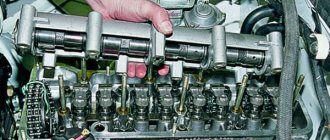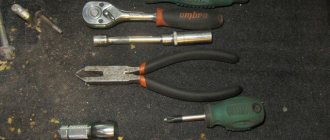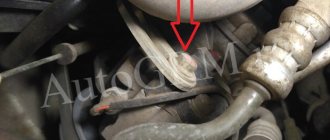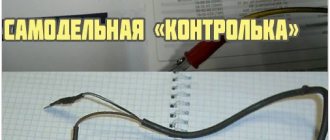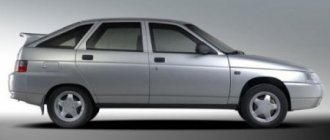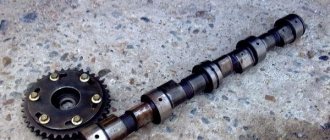How to distinguish the intake camshaft from the exhaust camshaft on a VAZ-2112: differences
The camshafts of the 16-valve VAZ-2112 admit the working mixture and release exhaust gases. Unlike an 8-valve engine, where one camshaft serves for intake and exhaust, on a 16-valve engine there is a separate element for each phase. This improves not only engine performance, but also contributes to lower fuel consumption.
Advantages of a sixteen-valve engine
We have already said that the internal combustion engines of the VAZ-2110 (2112) family discussed in the article are distinguished by greater power, lower fuel consumption, and also high technical characteristics, unlike the V8s. It's time to find out what design features make the VAZ 2112 16 valve engine such an attractive choice for motorists.
Let’s immediately make a reservation about exactly what “advantages” will be discussed in this section of the article:
- fuel economy;
- higher power;
- detonation resistance;
- advanced cooling system;
- simple tuning due to the separation of the intake and exhaust tracts.
It is the separation between the intake and exhaust tracts in the design of the VAZ-21120 and 21124 engines that makes it possible to achieve quite noticeable fuel savings. Thus, the supply of fuel and the intake of exhaust gases is carried out by a separate spaced valve system, due to which there is no unwanted mixing of fuel and combustion products. It is also obvious that this increases the efficiency of the engine and its power.
Photo of intake and exhaust camshafts
The intake and exhaust camshafts are indicated by arrows in the photo. The photo shows the engine with the valve cover removed.
Camshaft difference
The difference between the intake and exhaust camshafts is the presence of a groove for the phase sensor
In fact, there is no difference in the design of the exhaust and intake camshafts. There is only one reason why they are not interchangeable. There is a lip on the intake camshaft that is designed for a valve timing sensor.
Some car enthusiasts install sports camshafts instead of standard factory camshafts, which increase power. This is where the significant difference begins.
The intake camshaft has a larger cam size, which in turn opens the valve not by 7.6 mm, but by 13.2. This allows the engine to increase power characteristics. So the exhaust itself has slightly different characteristics - the valve opens not by 7.6, but by 10.8 mm, which significantly adds power.
Differences in sporty camshafts
Help me deal with Priora!
#1 Offline Victor2109
- Beginning
- 5 Messages:
- Car: VAZ 2109
In general, I decided to make a capital investment and already regretted that I did not contact the service and decided to save!
The problem is that after a do-it-yourself overhaul the car will not start, the Priora engine is 126,
In general, what we have: fuel supply - the injectors are working, they spray correctly,
spark is good - coils, spark plugs are new, working,
the marks (and no matter how hard I tried) are right, perfect)
We flashed the ecu, as soon as we didn’t flash it, it just started,
RESULT: WILL NOT START, hits the muffler in the air vent, tries to make the sound that it should, but in vain,
don’t scold me))) I will be glad for any help!
From attempts, oil was poured into the cylinders mixed with gasoline - 0, marks on the camshafts
I tried a tooth ahead - 0, with a pusher - 0, in general I have no strength anymore))) it’s a shame)) what could have gone wrong, where to look for the problem.
#2 Offline Zahar
Moderator 17,992 Messages:
Car: Toyota and Niva
1. I don’t remember well anymore, let someone in the know correct me. according to the marks, the crankshaft makes two revolutions, and the camshaft makes one revolution, sometimes the marks coincide, but it is still not set correctly, you need to remove the belt, turn the crankshaft one revolution, and again the marks will coincide. So?
2. did you measure the compression?
How to distinguish the intake camshaft from the exhaust camshaft of a VAZ-2112: photo
The camshafts of the 16-valve VAZ-2112 admit the working mixture and release exhaust gases. Unlike an 8-valve engine, where one camshaft serves for intake and exhaust, on a 16-valve engine there is a separate element for each phase. This improves not only engine performance, but also contributes to lower fuel consumption.
Photo of intake and exhaust camshafts
The intake and exhaust camshafts are indicated by arrows in the photo. The photo shows the engine with the valve cover removed.
Camshaft difference
The difference between the intake and exhaust camshafts is the presence of a groove for the phase sensor
In fact, there is no difference in the design of the exhaust and intake camshafts. There is only one reason why they are not interchangeable. There is a lip on the intake camshaft that is designed for a valve timing sensor.
Some car enthusiasts install sports camshafts instead of standard factory camshafts, which increase power. This is where the significant difference begins.
The intake camshaft has a larger cam size, which in turn opens the valve not by 7.6 mm, but by 13.2. This allows the engine to increase power characteristics. So the exhaust itself has slightly different characteristics - the valve opens not by 7.6, but by 10.8 mm, which significantly adds power.
Differences in sporty camshafts
conclusions
The camshafts of the 16-valve engine on the VAZ-2112 do not differ in design features, except that an additional edge is machined on the intake shaft for the camshaft (phase) sensor. If the intake and exhaust elements are swapped in places, this will lead to a violation of the valve timing, and if the engine operates in this mode for a long time, the owner will inevitably face a major overhaul of the cylinder head, at best.
16-valve 2008
16-valve 2008
The “smallest” of the 16-valve engines of the Volga Automobile Plant is the VAZ-11194 with a displacement of 1.4 liters. Two 1.6-liter models are also being produced - the already somewhat outdated VAZ-21124 and its more modern and powerful version, the VAZ-21126, which is gradually replacing its predecessor on the production line. Pay attention to the graph with engine characteristics: at crankshaft speeds close to maximum, the power and torque characteristics of the VAZ-11194 and VAZ-21124 are practically the same - and only at lower speeds is the “baby” inferior to its older brother. But engine 21126 is significantly - about 10% - more powerful and high-torque than the other two.
Let's get acquainted with their filling.
Cylinder blocks 21124 and 21126 are cast from cast iron. Compared to the previous one and a half liter analogue 2112, they are 2.3 mm higher (distance from the axis of the main bearings to the upper plane of the block). The cylinder diameter of engines 21124 and 21126 is the same - 82 mm. For selective engine assembly, 21124 blocks according to cylinder diameter are divided into five classes every 0.01 mm (A, B, C, D, E). Block 21126 has three classes separated by the same 0.01 mm (A, B, C). The cylinder class mark is located on the bottom plane of the block.
Other block sizes are identical. But there are differences in the requirements for processing the cylinder walls. Honing of cylinders 21124 is carried out according to the technology and requirements of AVTOVAZ, and 21126 - in accordance with the more stringent requirements of the Federal Mogul company, which have led to stricter requirements for the roughness of working surfaces. In order not to mix up the blocks, in addition to the markings made in the casting on the left wall of the block, the serial number is printed on the rear wall next to the fourth cylinder. Block 21124 is painted blue, and block 21126 is gray.
The cylinder block of the 11194 engine is similar in design to the 21126 block, but the cylinder diameter is smaller - 76.5 mm versus 82 mm. The processing of the cylinder walls is also in accordance with the requirements of Federal Mogul. Markings are in the same places, the block is painted blue. In addition, in block 11194 there are cooling jacket ducts between the cylinders, but 1.6 liter engines do not have them. For selective engine assembly, 11194 blocks are divided into three classes by cylinder diameter at 0.01 mm intervals (A, B, C).
The 21124 engine uses a 2110 connecting rod - steel, I-section, with a steel-bronze bushing in the upper head and axial fixation along the lower head (pictured above). The connecting rod cover is secured with two bolts pressed into the connecting rod. Based on the diameter of the bushing hole for the piston pin, connecting rods are divided into three classes every 0.004 mm. The hole class number is marked on the upper end of the connecting rod.
Engines 11194 and 21126 use connecting rod 11194, which is not interchangeable with connecting rod 2110. The new connecting rod, although it has grown from 121 mm to 133.5 mm, has become lighter - on average, it has “lost weight” from 683 to 412 g, which has seriously reduced inertial loads . Its axial fixation is ensured by the upper(!) head - along the piston. In this case, the steel part is in contact with the aluminum part, which reduces friction losses compared to the 21124 engine, where the steel connecting rod rubs against the cast iron surfaces of the crankshaft, and the friction speed is lower. The lower head, made using breaking technology, has become more elegant. Its cover is attached to the connecting rod with two bolts. Lengthening the connecting rod reduced the force of lateral pressure of the piston on the cylinder.
Installation and replacement of VAZ-2112 camshafts 16 valves: photo, video
Replacement of camshafts on the 16-valve VAZ-2112 engine occurs when they wear out and the support journals wear out. Most often this happens when the time for a major overhaul of the power unit or cylinder head passes. This is a rather complicated procedure, but you can really do it yourself.
The video below shows the installation of camshafts and split gears on a 16-valve engine of the VAZ family
The video material will tell you how to replace camshafts on a VAZ-2112 16 valves, and give some recommendations and advice.
Camshaft replacement process
Camshafts with gears and fasteners
In order to install camshafts on the VAZ-2112 16 valves, they must first be dismantled. Like any spare part, they are installed in the reverse order from disassembly.
So, let's look at the step-by-step process of removing and installing the intake and exhaust camshaft.
Removing camshafts
- To begin with, as with any repair operations, it is necessary to remove the “minus terminal” from the battery.
- Remove the timing belt cover.
After unscrewing the mounting bolts indicated in the diagram, remove the timing cover
Now, you need to remove the valve cover. Please note that the bolt tightening order must be followed during assembly.
Unscrew the fastening nuts and remove the valve cover.
Disconnect the wires of the emergency oil pressure sensor, and then unscrew it.
Disconnect the emergency oil pressure sensor
Using a socket wrench or 8mm socket, unscrew the 20 bolts securing the camshaft cover.
Scheme for dismantling and tightening the camshaft bearing housing bolts
- We dismantle the camshaft bearing housing.
- Now, there is free access to two plugs that are located on the rear side of the cylinder head. We take them out.
You need to be careful with the camshaft plugs; if you install them incorrectly, oil will leak out. If you don’t notice it in time, you’ll shorten the engine’s lifespan or end up in need of a major overhaul.
Remove the two rear cylinder head plugs
- We take out the intake camshaft.
- We take out the exhaust camshaft.
We remove the camshafts from their seats
We press the seals out of the camshafts.
Remove the seals from the camshaft. If it does not come off, carefully cut it or pry it off with a screwdriver.
Installation of camshafts
Now that everything is removed, you can proceed to installing new camshafts on the car:
What to do
Drivers had to deal with the fact that occasionally after the start an incomprehensible knocking sound began to appear, but when accelerating and warming up the engine it disappeared.
As we have already figured out, most likely the camshaft on the engine has failed. Now another question. What to do in such a situation? If it is the camshaft that starts knocking, you should be prepared to spend a considerable amount of money. But this is not a 100% probability, since sometimes hydraulic compensators begin to knock, or knocking noises are made by worn gears and bearings. Not all situations solve the problem by replacing the entire camshaft. If you suspect a knocking noise from this unit, it is better to immediately go for diagnostics. Due diligence can help you find out where the source of the problem is and what needs to be done about it.
Tuning and sports camshafts
Each of us tries in every possible way to improve our car, and there are a great many ways to achieve this. When it comes to the engine, everyone unanimously talks about increasing its power. Although, if we take a more serious approach to the issue, then first we need to pay attention to its torque.
We know that it is possible to squeeze out the most power at a stable maximum speed, but this engine mode is rarely used. For the average driver, what is more important is the car’s throttle response, which obediently responds to the gas pedal both when moving from a standstill and when accelerating. This behavior of the car is ensured by large and relatively constant torque at low and medium speeds, which is what VAZ engines “sin” about. At low engine speeds they do not have sufficient “traction”.
Owners of a VAZ car often complain about the car jerking when starting to move, noticeable dips when sharply pressing the gas, many have a fast clutch, and almost everyone notes the ineffectiveness of fifth gear. Indeed, at engine speeds less than 3000 rpm. its insufficient pickup capacity is observed. The torque curve depends on the valve timing parameters, the so-called “camshaft phases”, as well as the “time-section” of valve opening, which are determined by the profile of the camshaft cams. Depending on its angle of rotation, different amounts of valve opening are obtained. For better functioning of the car at low speeds, they quickly supply the required volume of working mixture into the cylinder, that is, they noticeably narrow the opening phase of the intake valve.
Unlike conventional camshafts, sports models use cams with different geometric dimensions. Their taller and wider shape means that the valve rises to a greater height and stays open longer, which ensures the supply of a complete mixture. The profile of the cams is characterized by a smooth shape, which makes the operation of the gas distribution mechanism more reliable at wide phases.
From the above it follows that the maximum engine power and its torque can have different values. And if the use of a standard camshaft implies increased torque at medium speeds, then the sports one provides maximum output at high engine speeds. The sports camshaft on VAZ cars is installed with a split gear (camshaft sprocket or pulley), with the help of which more precise adjustment and adjustment of the phases becomes possible. With its help, the maximum power is adjusted at the required engine speed.
By using tuning camshafts, you can achieve engine operation under load without noticeable interruptions, even when the speed is reduced to the maximum level. At the same time, the detonation limit moves away, that is, the “knock of fingers” at low and medium crankshaft speeds stops. There is a noticeable reduction in fuel consumption and exhaust toxicity. As a result, the engine’s tendency to detonate decreases, which means its service life increases.
Camshafts on VAZ engines are quite sensitive to gap adjustment, so on tuning camshafts the cam run-off area on the valve closing side is noticeably increased. This makes it easier to adjust the gaps and reduces their number several times. Let's trace this fact using the following example: after installing a tuning camshaft, valve clearance adjustment is required after 60,000 km of engine mileage. Using a conventional camshaft would require at least four adjustments. This significantly increases the service life of the product and saves money and time required for each valve adjustment. Do the math for yourself: proper adjustment takes at least 3.5 hours and costs about $20.
Camshaft classification
Low camshafts
Overhead camshafts
Help me deal with Priora!
#1 Offline Victor2109
- Beginning
- 5 Messages:
- Car: VAZ 2109
In general, I decided to make a capital investment and already regretted that I did not contact the service and decided to save!
The problem is that after a do-it-yourself overhaul the car will not start, the Priora engine is 126,
In general, what we have: fuel supply - the injectors are working, they spray correctly,
spark is good - coils, spark plugs are new, working,
the marks (and no matter how hard I tried) are right, perfect)
We flashed the ecu, as soon as we didn’t flash it, it just started,
Replacing the timing belt, tension roller, and water pump (pump) on Daewoo Lanos, Nexia, Chevrolet Lanos, Chevrolet Aveo, with a volume of
RESULT: WILL NOT START, hits the muffler in the air vent, tries to make the sound that it should, but in vain,
don’t scold me))) I will be glad for any help!
From attempts, oil was poured into the cylinders mixed with gasoline - 0, marks on the camshafts
I tried a tooth ahead - 0, with a pusher - 0, in general I have no strength anymore))) it’s a shame)) what could have gone wrong, where to look for the problem.
#2 Offline Zahar
Moderator17,992 Messages:
Car: Toyota and Niva
1. I don’t remember well anymore, let someone in the know correct me. according to the marks, the crankshaft makes two revolutions, and the camshaft makes one revolution, sometimes the marks coincide, but it is still not set correctly, you need to remove the belt, turn the crankshaft one revolution, and again the marks will coincide. So?
2. did you measure the compression?
In what cases is it necessary to change?
The pulleys of the 16-valve VAZ 2112 must be replaced when they are worn out or have mechanical damage. In particular, we are talking about:
- failure or exhausted service life of the pulley bearing journals;
- mechanical bending of the camshaft;
- spent service life, as well as scuffing of element cams.
Lada 2112 with 16 cl internal combustion engine
If some kind of extraneous knock appears in the valves while the engine is running, it is usually caused by one of these damages. If you have recorded a reduced pressure of the engine fluid in the system, this may indicate an increase in the clearances in the bearings.
To do this, in order to eliminate this malfunction, it is necessary to grind and restore the pulley bearing journals. You should also enlarge the grooves through which the engine fluid flows. This is done so that the lubricating fluid, after the next grinding, lubricates the internal combustion engine elements.
Cylinder head repair
We mark all hydraulic compensators with numbers using an ordinary clerical touch and put them away. An ordinary magnet will help you pull them out. We dry out the valves and remove the oil seals (valve seals), the valves into scrap metal, the oil seals into the trash. We clean all channels. We take the head for grinding, just in case. After washing it again with kerosene after sanding and blowing it with air, we begin to assemble it.
We arrange the freshly purchased valves in the sequence in which they will stand in the cylinder head and begin to grind in one by one. Lubricate the valve stem with clean oil and apply lapping paste to the edge.
We insert the valve into place and put a valve grinding tool on the valve stem. The stores sell a device for manual lapping, but since this is the twenty-first century, we are mechanizing the process. We take the old valve and cut off the rod from it, select a rubber tube for it of such a diameter that it fits tightly. The rod is in a reversible drill, one end of the tube is on it, the other is on the valve being ground in. At low speeds we begin to grind the valve, constantly change the direction of rotation and periodically press it to the seat or weaken the force. On average, the valve takes about twenty seconds. We take it out and wipe it. The valve is considered ground in if a uniform gray strip of at least 1.5 mm wide appears on the chamfer.
The same stripe should appear on the valve seat.
Video of manually grinding valves
For a sixteen valve head, everything is the same, only there are twice as many valves. After lapping, all valves and seats are thoroughly wiped and washed with kerosene to remove any remaining lapping paste. We check for leaks. We tighten the old spark plugs and put all the valves in place. Pour kerosene and wait three minutes, if the kerosene does not run away all is well, otherwise we grind the valves on this cylinder.
We had to grind four valves again, after which the kerosene stopped flowing.
We stuff new valve seals.
We put the valves in place and dry them. Before doing this, lubricate the valve stems with clean oil. After lubricating it with clean oil, we put the hydraulic compensators in place and, covering them with a clean cloth, remove the head out of sight. We're done with the cylinder head.
Lada Priora Hatchback › Logbook › Installed camshafts nuzhdin 8.7
In general, I installed the rollers on the machine! Priora with air conditioning and this caused a lot of difficulties through which I had to go through sleight of hand and mind. In this article I will help you walk this difficult path :))
First, we go to the store, or rather, we go and stock up on the following tools:
1) Heat-resistant sealant - red in a syringe 2) Camshaft seals and plugs, if the mileage is over 100 tons km 3) Timing belt, pump, rollers, if the mileage is over 50 tons km 4) A 13-socket wrench with a moving joint 5) A flexible screwdriver with nozzle 13 6) Heads: 8, 13, 10 and a wrench, respectively 1/2 7) Napkins, rags, rags, cotton swabs Long screwdriver with a flat slot, and also a screwdriver with a Phillips + flat slot 9) Hydraulics from 3 pcs up to 16, depending on the mileage of the car 60 t. km - 200 t. km 10) Priorovsky pulley tensioner, generator belt roller tensioner + 17 socket wrench 11) Set of hexagons 12) Spare bolts 2-3 pcs for cylinder head bed and valve cover .
Long screwdriver with a flat slot, and also a screwdriver with a Phillips + flat slot 9) Hydraulics from 3 pcs up to 16, depending on the mileage of the car 60 t. km - 200 t. km 10) Priorovsky pulley tensioner, generator belt roller tensioner + 17 socket wrench 11) Set of hexagons 12) Spare bolts 2-3 pcs for cylinder head bed and valve cover .
Let's get started: 1) remove the filter box by taking out the rubber supports. Either replace them later, or use a sharp knife to trim the rubber on top, remove them from the filter box, and put them on the supports on the machine, and then place the box on them. 2) remove the corrugation going from the air flow sensor to the throttle 3) remove the throttle valve by unscrewing the bolts 13 4) remove the low crankcase ventilation and high crankcase ventilation hoses, remove the throttle control rod, move the throttle down, do not touch the cooling system hoses. 5) disconnect the vacuum brake booster hose from the receiver 6) remove the individual ignition coils by unscrewing the bolts by 10 7) move the braid to the side with the ignition wires to the side and the other braid. unscrew the belt roller with a 17 wrench generator-crankshaft-conder and remove it as well as the belt to the side 9) unscrew the upper support of the generator with 13 wrenches, move it to the side 10) unscrew the upper receiver supports with a 10 wrench, put all the nuts in the box. 11) from below, on the pit, unscrew the 3 nuts securing the receiver along the contour, using a 13mm wrench with a hinge. as well as the rightmost bolt. We tore it off with a key, then unscrew it by putting the head on 13 by hand. Do not lift the car with two jacks! If there is a crankcase protection, unscrew it first. 12) we tear off the left bolt with a spanner wrench and unscrew it with a bendable screwdriver with a 13-short nozzle. 13) remove the receiver, move it towards you, don’t forget to find all 5 washers! 14) use two flat-head screwdrivers to remove the plugs from 4 injectors, it’s very inconvenient, there’s a lock on the plug, we bend the wire on the plug from below with a screwdriver, you’ll see it opens on the sides. Without this, the receiver cannot be removed without damage. 15) remove the receiver, half the battle is over! 16) remove the plastic timing belt protection using the hexagon from the kit 17) jack up the right front wheel, turn the wheel until the top dead center and the marks on the pulleys match, engaging 5th gear. There is a mark on the toothless pulley at the bottom, and slots on the top of the pulleys. If you change the timing belt, you need to remove the wheel and pulley. 18) tear off the nuts on the pulleys, securing the pulley from turning 19) unscrew the tension roller with a 15 wrench 20) remove the timing belt from the camshaft pulleys and to the side, do not allow oil to get on it! 21) unscrew the nuts on the pulleys and remove the pulleys 22) along the contour, unscrew the 8 bolts on the cylinder head valve cover. 23) remove the valve cover, we see the bed with camshafts. 24) unscrew the 8 bolts along the contour on the cylinder head bed. 25) remove the bed and take out the camshafts. We check the hydraulics for compression by pressing with a finger; if there is compression, replace them. We remove all the hydraulics and check whether the new camshafts rotate. put the hydraulics in place. 26) coat the adjacent parts of the bed with a thin layer of sealant, having previously degreased them. 27) place the other shafts with the keys up, the guideline is TDC slots. There are two inlet tides, one outlet. 28) tighten the bed bolts along the contour not to a torque of 20 nm, but most likely to 10 nm, otherwise they will spin and break off. you will feel when the limit is reached, if they start to scroll, unscrew and re-tighten another new bolt. I already picked one, fortunately it came out of the woodwork. Walk along the bed, smoothly, increasing the tightening force, over all bolts. Don’t forget about the camshaft seals, it’s better to install them before tightening the cylinder head bed, as well as the plugs. 29) also with the valve cover, but first, put on the pulleys and align them with the TDC slots. 30) Check all the marks and put on the timing belt, roller, and spin the wheel, then check that all the marks match. 30) everything is in reverse order. Tired of writing, let alone doing it all!
Either replace them later, or use a sharp knife to trim the rubber on top, remove them from the filter box, and put them on the supports on the machine, and then place the box on them. 2) remove the corrugation going from the air flow sensor to the throttle 3) remove the throttle valve by unscrewing the bolts 13 4) remove the low crankcase ventilation and high crankcase ventilation hoses, remove the throttle control rod, move the throttle down, do not touch the cooling system hoses. 5) disconnect the vacuum brake booster hose from the receiver 6) remove the individual ignition coils by unscrewing the bolts by 10 7) move the braid to the side with the ignition wires to the side and the other braid. unscrew the belt roller with a 17 wrench generator-crankshaft-conder and remove it as well as the belt to the side 9) unscrew the upper support of the generator with 13 wrenches, move it to the side 10) unscrew the upper receiver supports with a 10 wrench, put all the nuts in the box. 11) from below, on the pit, unscrew the 3 nuts securing the receiver along the contour, using a 13mm wrench with a hinge. as well as the rightmost bolt. We tore it off with a key, then unscrew it by putting the head on 13 by hand. Do not lift the car with two jacks! If there is a crankcase protection, unscrew it first. 12) we tear off the left bolt with a spanner wrench and unscrew it with a bendable screwdriver with a 13-short nozzle. 13) remove the receiver, move it towards you, don’t forget to find all 5 washers! 14) use two flat-head screwdrivers to remove the plugs from 4 injectors, it’s very inconvenient, there’s a lock on the plug, we bend the wire on the plug from below with a screwdriver, you’ll see it opens on the sides. Without this, the receiver cannot be removed without damage. 15) remove the receiver, half the battle is over! 16) remove the plastic timing belt protection using the hexagon from the kit 17) jack up the right front wheel, turn the wheel until the top dead center and the marks on the pulleys match, engaging 5th gear. There is a mark on the toothless pulley at the bottom, and slots on the top of the pulleys. If you change the timing belt, you need to remove the wheel and pulley. 18) tear off the nuts on the pulleys, securing the pulley from turning 19) unscrew the tension roller with a 15 wrench 20) remove the timing belt from the camshaft pulleys and to the side, do not allow oil to get on it! 21) unscrew the nuts on the pulleys and remove the pulleys 22) along the contour, unscrew the 8 bolts on the cylinder head valve cover. 23) remove the valve cover, we see the bed with camshafts. 24) unscrew the 8 bolts along the contour on the cylinder head bed. 25) remove the bed and take out the camshafts. We check the hydraulics for compression by pressing with a finger; if there is compression, replace them. We remove all the hydraulics and check whether the new camshafts rotate. put the hydraulics in place. 26) coat the adjacent parts of the bed with a thin layer of sealant, having previously degreased them. 27) place the other shafts with the keys up, the guideline is TDC slots. There are two inlet tides, one outlet. 28) tighten the bed bolts along the contour not to a torque of 20 nm, but most likely to 10 nm, otherwise they will spin and break off. you will feel when the limit is reached, if they start to scroll, unscrew and re-tighten another new bolt. I already picked one, fortunately it came out of the woodwork. Walk along the bed, smoothly, increasing the tightening force, over all bolts. Don’t forget about the camshaft seals, it’s better to install them before tightening the cylinder head bed, as well as the plugs. 29) also with the valve cover, but first, put on the pulleys and align them with the TDC slots. 30) Check all the marks and put on the timing belt, roller, and spin the wheel, then check that all the marks match. 30) everything is in reverse order. Tired of writing, let alone doing it all!
source
